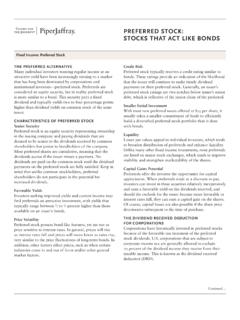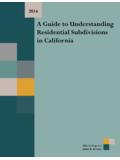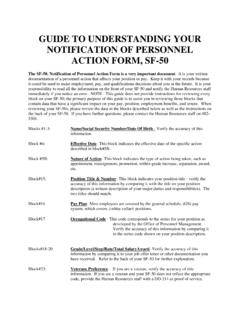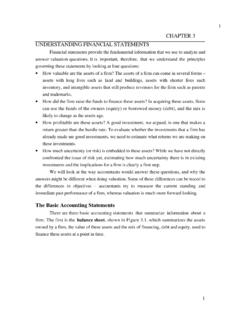Transcription of A GUIDE TO UNDERSTANDING FLOATING-RATE SECURITIES
1 A GUIDE TO UNDERSTANDING . FLOATING-RATE SECURITIES . WHAT ARE FLOATING-RATE INVESTMENTS? A floater's coupon can reset as often as daily or as A FLOATING-RATE investment, also known as a floater, is an infrequently as once per year. It is quite common for the investment with interest payments that float or adjust coupon to reset each time an interest payment is made and periodically based upon a predetermined benchmark. While then remain constant until the next coupon payment date. floaters may be linked to almost any benchmark and pay If the floater resets more frequently than interest is paid, the interest based on a variety of formulas, the most basic type coupon payment will reflect the average of each reset since pays a coupon equal to some widely followed interest rate the previous interest payment.
2 For example, a bond with a plus a fixed spread. Only this type of floater will be monthly reset/quarterly pay structure will pay interest discussed in this article. consisting of the average of the three monthly reset rates that occurred during the previous quarter. HOW ARE FLOATERS STRUCTURED? The most important determinant of a floater's performance A floater may be issued as either non-callable or callable. If is the underlying benchmark, or reference rate. Reference issued as callable, it can be called only by the issuer prior to rates typically used as benchmarks include Treasury maturity. Floaters have a variety of maturities, although bills (T-bills), the London Interbank Offered Rate (LIBOR), most are issued with maturities of 10 years or less.
3 The Prime Rate or some other short-term interest rate. UNDERSTANDING CAPS AND FLOORS. Once the benchmark is chosen, the issuer will establish an Many floaters are issued with either a cap, a floor or additional spread that it is willing to pay in excess of the both. A cap is the maximum interest rate the issuer will reference rate. This spread is generally expressed in basis pay regardless of how high the reference rate may go, and points (a basis point is one one-hundredth of one percent or it protects the issuer from escalating interest costs. ) and is added to the reference rate to determine the Conversely, a floor sets the minimum rate that will be paid overall coupon. For example, a floater may be issued with a even if the coupon determined by the reference rate were spread of 40 basis points above the three-month T-bill rate.
4 Lower, and it partially protects the investor from declining If the T-bill rate is percent on the day the floater is income. The following table illustrates the difference issued, its initial coupon will be percent ( + between two floaters that pay a spread of 40 basis points = ). The spread for any particular floater will above the reference rate one with a 4 percent cap and be based on a variety of factors, including the credit quality 2 percent floor, and one without a cap or floor. of the issuer and the time to maturity. It is important to note that since short-term rates are usually lower than long- term rates , the initial coupon of a floater is typically lower UNDERSTANDING CAPS AND FLOORS. than that of a fixed-rate note of the same maturity.
5 Ref. With No Another important component of a floater's structure is the Rate Cap/Floor Cap/Floor reset frequency how often the interest rate is adjusted to reflect the current reference rate. Continued .. A GUIDE to UNDERSTANDING FLOATING-RATE SECURITIES FLOATER ADVANTAGES WHAT ARE THE RISKS OF FLOATING-RATE INVESTMENTS? Benefit from Rising Interest rates Interest Rate Risk Investors are sometimes reluctant to lock in a current While the market value of a floater is relatively insensitive fixed rate for the long term because they believe rates will to changes in interest rates , the income received is, of rise in the future. However, rates available on short-term course, highly dependent upon the level of the reference rate investments may be lower than the investor is willing to over the life of the investment.
6 Total return may be less than accept. Floaters offer an alternative that pays a spread anticipated if future interest rate expectations are not met. above current short-term rates and also enjoys the benefit of future rate increases. Credit Risk As with any fixed-income investment, there is a risk that the Limited Price Sensitivity to Interest rates issuer will be unable to meet its payment obligations. Credit Fixed-rate bonds tend to decrease in value when interest rates ratings serve as a measure of the issuer's financial health rise and increase in value when rates fall. The bond's value and should be taken into account when considering a changes to compensate for the difference between its fixed purchase of floaters.
7 In addition, because the spread paid in coupon rate and current interest rates . Because a floater's excess of the reference rate is determined in part by the coupon rate changes when market rates change, its price will issuer's credit rating, changes in this credit rating can also fluctuate far less than fixed-rate bonds of similar maturity. affect the market value of the investment. WHO INVESTS IN FLOATERS? Call Risk Investors who believe that interest rates will rise and are If a callable floater is called by the issuer prior to maturity, dissatisfied with low short-term rates may consider a the investor may be unable to reinvest funds in another FLOATING-RATE investment. floater with comparable terms. If the floater is not called, the investor should be prepared to hold it until maturity.
8 WHO ISSUES FLOATERS? Both government-sponsored enterprises (GSEs) and corporations issue floaters as part of their overall funding strategy. IS THERE A SECONDARY MARKET? Floaters are most suitable for purchasing and holding to maturity. However, investors may find it necessary to sell their FLOATING-RATE investment prior to maturity. Floaters may be traded in the secondary market, providing an opportunity for investors to sell them at then prevailing market levels, which means they may be worth more or less than the original amount invested. Since 1895. Member SIPC and NYSE. 2005 Piper Jaffray & Co. 5/05 PA-03-1559












